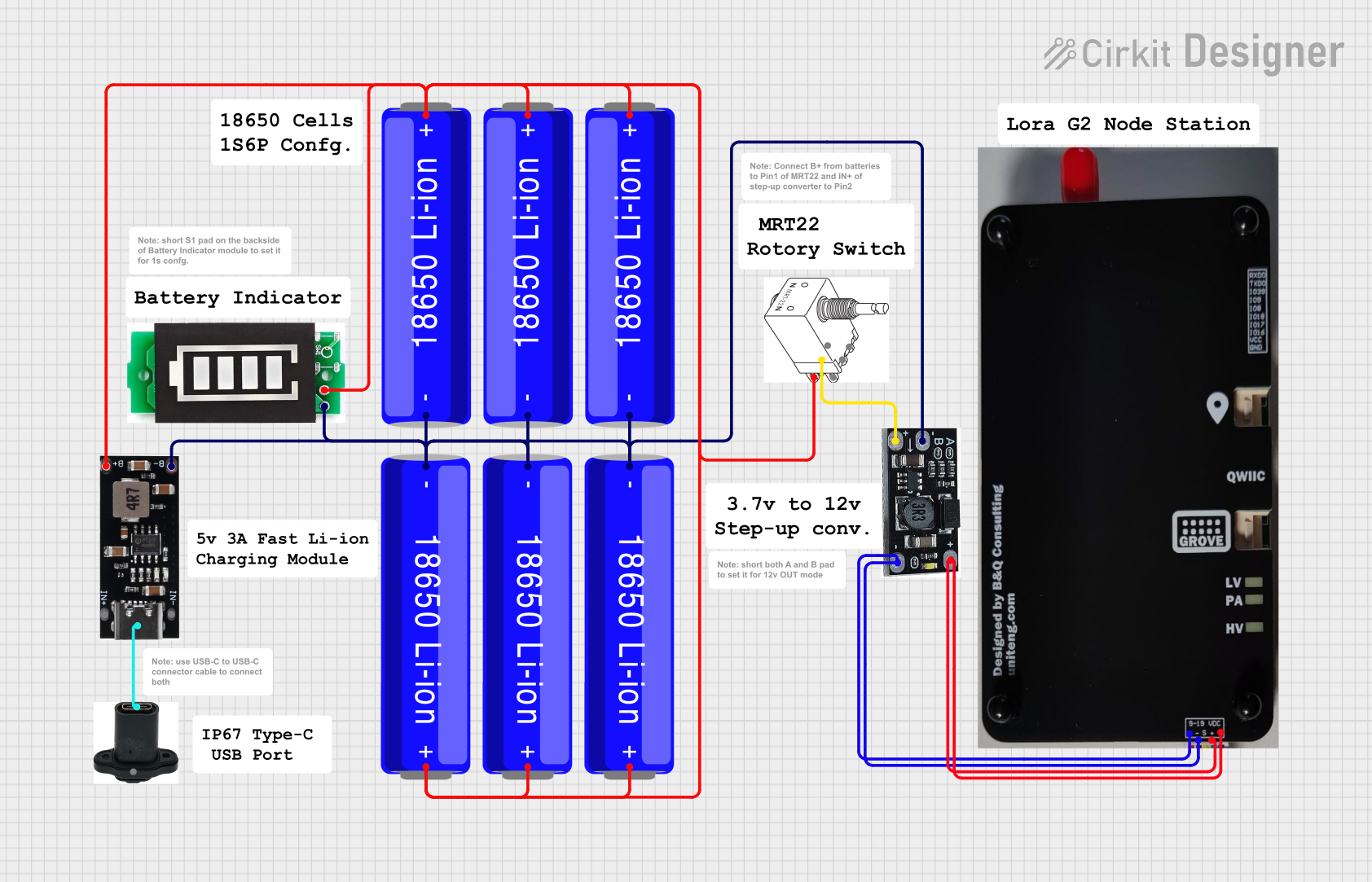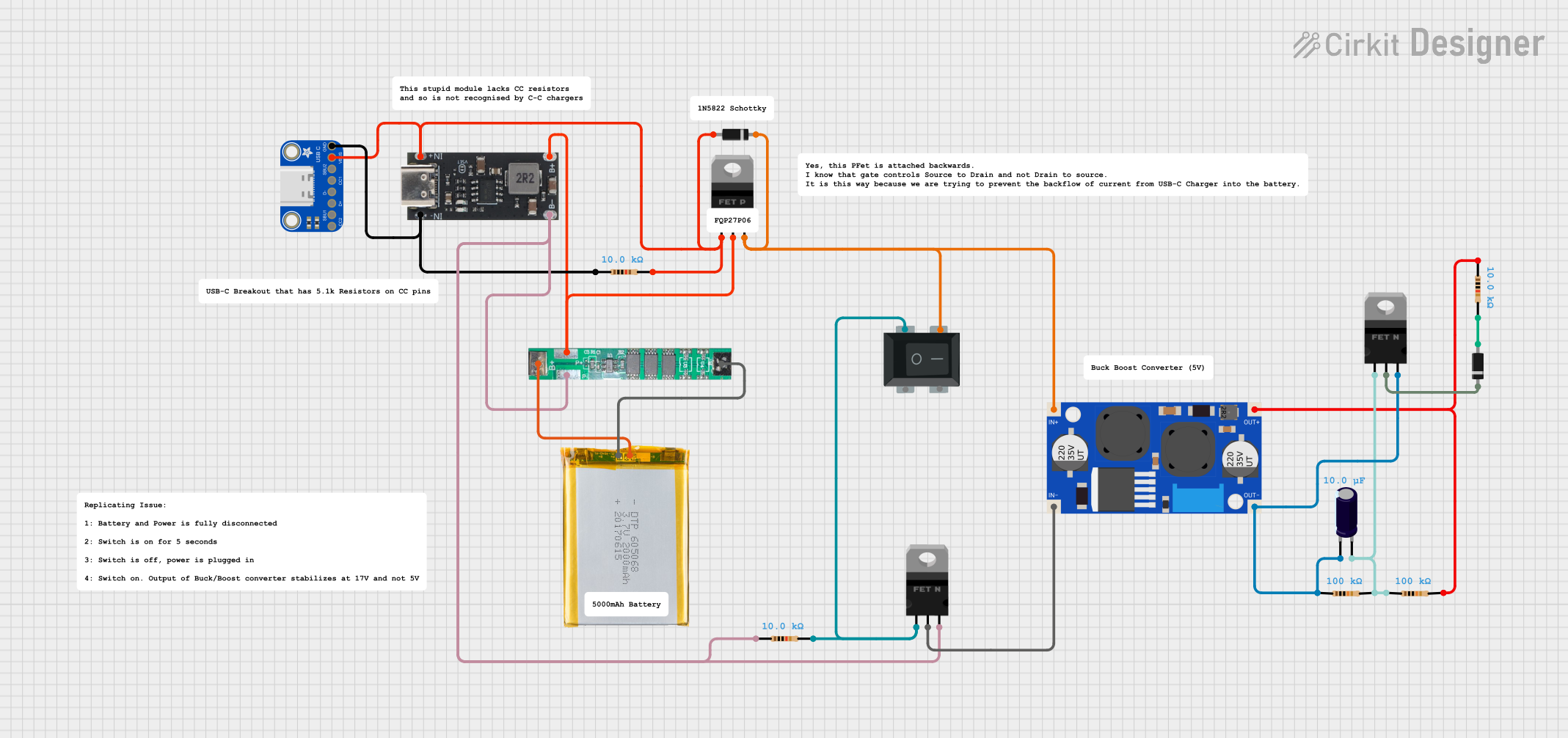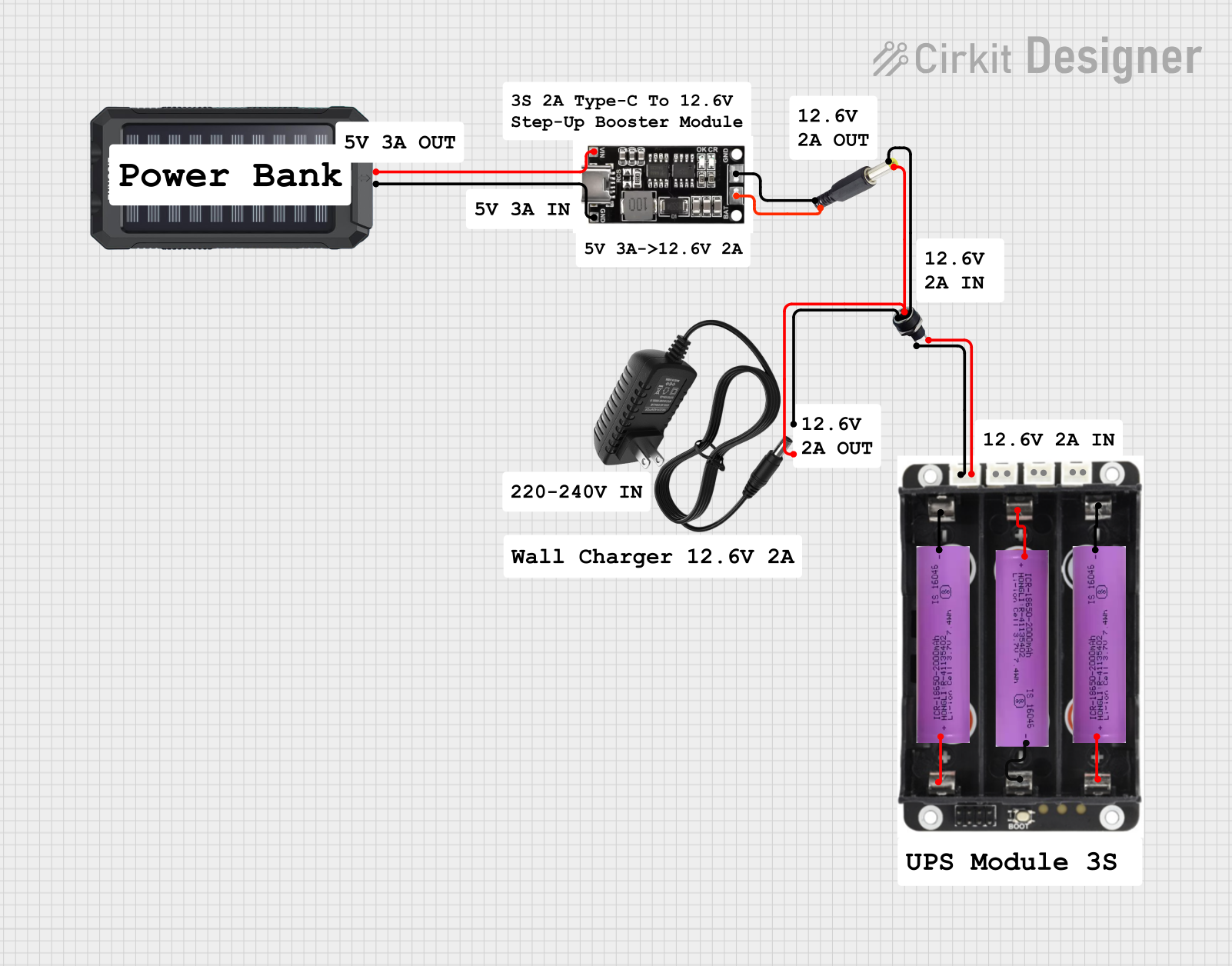
How to Use Type-c Power Bank Module: Examples, Pinouts, and Specs

 Design with Type-c Power Bank Module in Cirkit Designer
Design with Type-c Power Bank Module in Cirkit DesignerIntroduction
The Type-C Power Bank Module is a compact and versatile electronic component designed for energy storage and delivery. Manufactured by Arduino/ESP32, this module features a USB Type-C interface for efficient charging and discharging of devices. It is commonly used in portable power bank applications, DIY electronics projects, and as a power supply for microcontroller-based systems.
Explore Projects Built with Type-c Power Bank Module

 Open Project in Cirkit Designer
Open Project in Cirkit Designer
 Open Project in Cirkit Designer
Open Project in Cirkit Designer
 Open Project in Cirkit Designer
Open Project in Cirkit Designer
 Open Project in Cirkit Designer
Open Project in Cirkit DesignerExplore Projects Built with Type-c Power Bank Module

 Open Project in Cirkit Designer
Open Project in Cirkit Designer
 Open Project in Cirkit Designer
Open Project in Cirkit Designer
 Open Project in Cirkit Designer
Open Project in Cirkit Designer
 Open Project in Cirkit Designer
Open Project in Cirkit DesignerCommon Applications and Use Cases
- Portable power banks for charging smartphones, tablets, and other USB devices.
- Power supply for Arduino, ESP32, and other microcontroller projects.
- Backup power solutions for small electronic devices.
- DIY electronics projects requiring a rechargeable power source.
Technical Specifications
The following table outlines the key technical details of the Type-C Power Bank Module:
| Parameter | Specification |
|---|---|
| Input Voltage | 5V (via USB Type-C port) |
| Output Voltage | 5V (regulated) |
| Output Current | Up to 2A |
| Battery Compatibility | 3.7V Li-ion/LiPo battery |
| Charging Current | 1A (default, adjustable in some models) |
| Protection Features | Overcharge, over-discharge, short circuit |
| Dimensions | 25mm x 20mm x 5mm |
Pin Configuration and Descriptions
The module typically includes the following pins and interfaces:
| Pin/Interface | Description |
|---|---|
| USB Type-C Port | Used for charging the connected battery and powering external devices. |
| BAT+ | Positive terminal for connecting the 3.7V Li-ion/LiPo battery. |
| BAT- | Negative terminal for connecting the 3.7V Li-ion/LiPo battery. |
| OUT+ | Positive output terminal for powering external devices. |
| OUT- | Negative output terminal for powering external devices. |
| Indicator LEDs | Status LEDs for charging, discharging, and battery level indication. |
Usage Instructions
How to Use the Component in a Circuit
- Connect the Battery: Attach a 3.7V Li-ion or LiPo battery to the BAT+ and BAT- terminals. Ensure correct polarity to avoid damage.
- Power Input: Use a USB Type-C cable to connect the module to a 5V power source for charging the battery.
- Power Output: Connect your load (e.g., Arduino, ESP32, or other devices) to the OUT+ and OUT- terminals. The module will regulate the output to 5V.
- Monitor Status: Use the onboard indicator LEDs to monitor charging, discharging, and battery status.
Important Considerations and Best Practices
- Battery Selection: Use only compatible 3.7V Li-ion or LiPo batteries with appropriate capacity and discharge ratings.
- Heat Management: Avoid overloading the module to prevent overheating. Ensure proper ventilation if used in enclosed spaces.
- Polarity Check: Double-check all connections to ensure correct polarity, especially for the battery terminals.
- Arduino/ESP32 Integration: When powering an Arduino or ESP32, connect the OUT+ to the 5V pin and OUT- to GND.
Example Code for Arduino UNO
If you are using the Type-C Power Bank Module to power an Arduino UNO, you can monitor the battery voltage using an analog pin. Here's an example:
// Example code to monitor battery voltage using Arduino UNO
const int batteryPin = A0; // Analog pin connected to battery voltage divider
float batteryVoltage = 0.0;
void setup() {
Serial.begin(9600); // Initialize serial communication
pinMode(batteryPin, INPUT); // Set the battery pin as input
}
void loop() {
int sensorValue = analogRead(batteryPin); // Read the analog value
// Convert the analog value to voltage (assuming a 10-bit ADC and 5V reference)
batteryVoltage = (sensorValue / 1023.0) * 5.0;
// Print the battery voltage to the Serial Monitor
Serial.print("Battery Voltage: ");
Serial.print(batteryVoltage);
Serial.println(" V");
delay(1000); // Wait for 1 second before the next reading
}
Note: Use a voltage divider circuit if the battery voltage exceeds the Arduino's ADC input range.
Troubleshooting and FAQs
Common Issues and Solutions
Module Not Charging the Battery:
- Ensure the USB Type-C cable and power source are functioning properly.
- Verify the battery is connected with the correct polarity.
- Check for any physical damage to the module.
No Output Voltage:
- Confirm the battery is charged and connected correctly.
- Inspect the OUT+ and OUT- connections for loose wires or poor contact.
Overheating:
- Reduce the load current if the module becomes excessively hot.
- Ensure proper ventilation around the module.
LED Indicators Not Working:
- Verify the module is receiving power.
- Check for damaged or faulty LEDs.
FAQs
Q1: Can I use this module with a 12V battery?
A1: No, this module is designed for 3.7V Li-ion or LiPo batteries only. Using a 12V battery may damage the module.
Q2: What is the maximum load current the module can handle?
A2: The module can handle up to 2A of output current. Exceeding this limit may trigger the protection circuit or damage the module.
Q3: Can I charge the battery and power a device simultaneously?
A3: Yes, the module supports simultaneous charging and discharging, but ensure the total current does not exceed the module's capacity.
Q4: How do I adjust the charging current?
A4: Some models allow adjustment of the charging current via onboard resistors or jumpers. Refer to the specific model's datasheet for details.